Neo Geo Pocket
Top 10 Best Neo Geo Pocket Games of All Time!
The Neo Geo AES was never expected to grow beyond its cult status, but the Neo Geo Pocket was an opportunity for SNK to reach a wider audience. The first iteration of the Neo Geo Pocket was released in 1998 with a monochrome screen, but it was quickly abandoned in favor of the Neo Geo Pocket Color. The system received many ports of popular SNK titles, and its “clicky” thumbstick lent itself well to arcade games. Sega was the only major third-party publisher to show support for the system, but this partnership led to a new Sonic game and allowed the Neo Geo Pocket to be linked with the Dreamcast as a means of unlocking new content. Unfortunately, the Neo Geo Pocket was never able to find its footing and the platform was discontinued a mere 20 months after its release. The success of Pokémon and strong competition from the Bandai WonderSwan created less-than-ideal market conditions for SNK.
10
Neo Turf Masters
1999
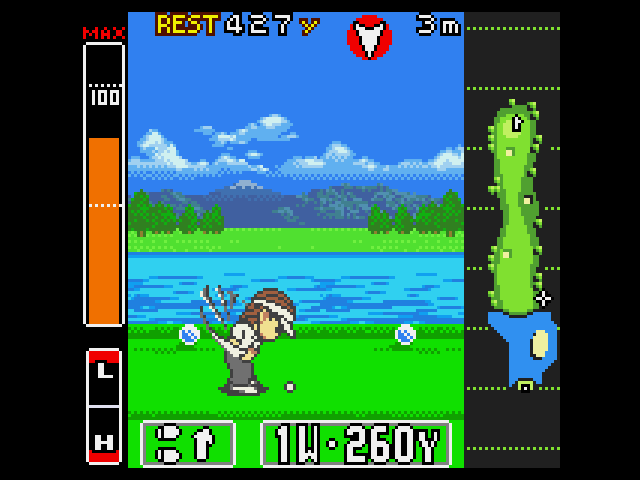
Golf games are appropriate for handheld systems since its relatively easy to follow the action on a small screen. Neo Turf Masters was originally released as an arcade game, so you know it’s going to be accessible and easy to pick up. The game isn’t as over-the-top as NBA Jam or as animated as the Mario-themed sports games, but it still moves along faster than the real sport does. The key to the game’s speed is an easy-to-understand control scheme that keeps things simple. Those playing the game for the first time will have no problems figuring out how adjust the power and trajectories of their shots. Although it’s easy to play, it’s pretty hard to master. The original game was designed to eat quarters, and the arcade mentality was carried over to the Neo Geo Pocket. Players are likely to knock the ball out of bounds a lot, and making par can be a bit of a struggle. The game doesn’t have much in the name of extras, but the quick pacing makes Neo Turf Masters a great fit for the Neo Geo Pocket and inviting for gamers that might not necessarily be interested in golf.
9
Puyo Pop
1999

Puzzle games and handheld systems have gone hand-in-hand dating back to Tetris on the Game Boy. There are a number of worthwhile puzzle games on the Neo Geo Pocket, but Puyo Pop stands out as the best. Puyo Puyo games were typically rebranded before being released in America (Dr. Robotnik’s Mean Bean Machine and Kirby’s Avalanche are both part of the series), but Puyo Pop is the first title to be released under the Puyo brand. I guess SNK figured that anyone who bought a Neo Geo Pocket Color wouldn’t be afraid of a game just because it had a quirky name. The goal in Puyo Puyo games is to group together falling blobs in accordance to their color. If you can understand color and gravity, you pretty much have all of the necessary tools for success. Puyo Puyo was somewhat revolutionary when it was first released because it encouraged players to plan ahead. Instead of simply clearing the playing field as quickly as possible, players were rewarded for chaining together combos to eliminate multiple blobs at once. Puyo Pop is basically a port of Puyo Puyo 2, which became an immediate hit in Japan following its 1994 arcade release. It features a number of computer-controlled opponents to compete against, but it’s most fun with a second player.
8
Metal Slug: 2nd Mission
2000

Metal Slug is a side-scrolling action game similar to Contra and arguably the most prolific SNK release outside of the fighting genre. The series was renowned for its incredible animation and highly-detailed sprites. The graphics on the portable version were obviously toned down, but the small characters retained most of their personality. The series was already comical to begin with, so the switch to 8-bit style graphics wasn’t as jarring as it was for some of SNK’s other games. Metal Slug: 1st Mission was a great start, but even its title suggested that better things were on the horizon. 2nd Mission had better levels, more vehicles, and a handful of gameplay refinements. There were nearly 40 stages to explore, and they were filled with branching pathways and hostages to save. The new save feature is greatly appreciated and made 1st Mission seem outdated in comparison. There’s also a surprising amount of variety, too. During the game, players will use shotguns, grenades, missile launchers, plains, tanks, and submarines. Strangely, one of the most interesting stages requires players to rely on stealth as they infiltrate an enemy base armed only with a knife. You can’t go wrong with either Metal Slug game, but 2nd Mission felt like an entirely new experience instead of a portable version of an existing arcade game.
7
King of Fighters R-2
1999

This list is just getting started, but there are going to be a lot of fighting games featured on it. SNK specialized in fighting games and the genre pretty much defined the entire Neo Geo brand. The Neo Geo Pocket was a much better candidate for fighting games than you might imagine. The small screen didn’t bleed, the two face buttons were pressure-sensitive, and the low-profile control stick had a clicking effect that gave a tactile feel to your inputs. King of Fighters R-1 was a launch game for the monochrome Neo Geo Pocket in 1998 and set the stage for every other fighting game on the system. It featured super deformed characters and emphasized expressions and animations rather than creating realistic body proportions. King of Fighters R-1 was surprisingly similar to its big brothers despite its childish exterior, and it supported the three-on-three team battles that the series was known for. King of Fighters R-2 launched alongside the Neo Geo Pocket Color in 1999 and was a lot prettier than its black-and-white predecessor. From a gameplay perspective, R-2 featured a surprisingly robust story mode that allowed players to upgrade characters and find various items to modify their attacks. The full-featured single-player mode was a great addition to the game, but you also had the option to link two Neo Geo Pockets if you wanted to compete against a human opponent.
6
Biomotor Unitron
1999

Biomotor Unitron was the first RPG released on the Neo Geo Pocket. The game is a dungeon crawler at its core, and most of your time will be spent exploring dungeons for money and fighting battles for experience. In most RPGs, your stats increase after earning a certain amount of arbitrary experience points. Biomotor Unitron takes a different approach. Instead of simply leveling up, players are given the opportunity to develop upgrades for their robot by using various tools and materials they obtain from their fallen opponents. Similar to how Mega Man beats his opponents up and steals their powers, your robot can gain new abilities by using materials obtained from his rivals. You can upgrade the robots attacking arms, legs, backpacks, armored plating, energy cores, and other parts using dozens of different materials. Rare materials can result in more powerful upgrades, but there is also an elemental aspect to be mindful of. Fire-based arms are effective against wooden enemies, for example, so it’s necessary to rotate your weapons and equipment on a regular basis. The menu-driven battles are fairly simplistic and the game’s story is pretty generic, but there is an incredible amount of upgrade combinations to experiment with. At the end of the day, building robots is a lot of fun.
5
SNK Gals’ Fighters
2000

SNK Gals’ Fighters is a fighting game with a roster comprised entirely of female characters from SNK games. Perennial favorites like Mai and Athena are present, but the game also includes a handful of obscure characters too (like Shiki from Samurai Shodown 64). It also features the most entertaining last boss to ever grace a fighting game. With only 11 fighters to choose from, the roster isn’t as deep as it could be; but the ladies all have a lot of personality. The super deformed characters are expressive, well-animated, and downright hilarious at times. Players can customize their fighters somewhat with items that they earn throughout the game. These items will max out your power meter, deplete your enemies health, or even give you an automatic win. Many of the items are purely cosmetic, but they still add to the overall charm of the game. The game’s combo and evade systems are similar to the Neo Geo Pocket versions of King of Fighters, but the game is much faster. It’s actually the fastest and most fluid fighting game on the system. Regardless of how fast things get, the action never becomes too hard to follow thanks to the clean art style. Most of the fighting games on this list were released on other formats, but SNK Gals’ Fighters is an entirely original game that was designed with the Neo Geo Pocket in mind. It’s one of the best reasons to own the system, and it’s baffling that it took SNK 18 year before they made another lighthearted all-female fighting game.
4
The Last Blade
2000
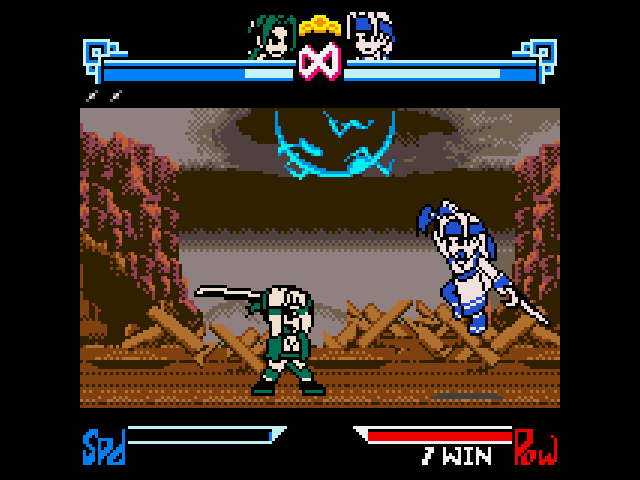
The Last Blade series is an obscure weapons-based fighting game set in the late 19th century. The most notable aspect of the franchise is its unique countering system. You can block attacks in the traditional manner by simply holding back on the control stick, but the game also gives players a separate button to allow them to repel attacks. By timing things properly, players can repel their opponents attacks in order to create openings. The game allows players to choose between two different fighting styles. The “power” and “speed” styles are self-explanatory, but I’ve always preferred the latter as it allows for more impressive combos. The Last Blade on the Neo Geo Pocket follows the story of the original game and also includes a number of fighters from The Last Blade 2. As with every other fighting game on the Neo Geo Pocket, the characters are defined by oversized heads and large eyes. Despite the cutesy appearance the game plays remarkably like the arcade and console counterparts, and the system’s pressure-sensitive buttons work really well. Lightly tapping the button will result in a weak slash, while applying more pressure will unleash a stronger attack. The Last Blade and its sequel rank among the most underrated Neo Geo games of all time, so it shouldn’t be surprising that the handheld version didn’t receive the attention it deserved.
3
Sonic the Hedgehog Pocket Adventure
1999

Sonic the Hedgehog Pocket Adventure was the first Sonic game to be released on a system that wasn’t made by Sega. (I’m not counting Sonic Jam for the Tiger game.com because it sucked.) Pocket Adventure borrows heavily from the Genesis version of Sonic the Hedgehog 2, but it features new bosses and includes music from various Sonic games. The Sonic series is built around speed, so you wouldn’t expect it to be a great fit for a handheld system with a sub-3″ screen. The game does a surprisingly good job of staying focused on the action and players are given ample time to react to enemies or obstacles. It’s kind of sad, but SNK took better care of the Sonic franchise than Sega did. In many ways, Sonic the Hedgehog Pocket Adventure feels like one of the last “pure” Sonic games. Subsequent games on other handheld systems put too much emphasis on Sonic’s shitty friends™, while the 3D Sonic games ranged from “pretty good” to “horrendous crimes against nature.” By 1999, the 16-bit era was already ancient history, but Sonic the Hedgehog Pocket Adventure was a reminder of a time when platformers were king. At the time of its release, Pocket Adventure was arguably the best side-scrolling platformer ever released on a handheld system.
2
SNK vs. Capcom: The Match of the Millennium
1999

SNK was making a pretty bold statement with their “Match of the Millennium” claim, but it really was a big deal for fans of fighting games. Capcom and SNK were fierce competitors for nearly a decade, so seeing them work together was about as shocking as a crossover between Marvel and DC would be. The amount of content in The Match of the Millennium is pretty amazing for a handheld fighting game. Players have the option to compete one-on-one or fight in teams consisting of two or three fighters. The roster itself includes 26 characters from SNK and Capcom games, and players can choose a Capcom-style level gauge, an SNK-style charge gauge, or a neutral meter that enhances super attacks. Each character has their own theme, and stages from both SNK and Capcom games are featured. Special attacks can also be unlocked in the game’s “Olympic” mode. In addition to the usual time-attack and survival events, the Olympic mode also has mini-games based on events from games like Metal Slug and Ghouls ‘n Ghosts. Like most fighting games on the Neo Geo Pocket, The Match of the Millennium allows players to link up to compete against each other. The game also allows you to link up with the Card Fighters Clash series and the Dreamcast version of Capcom vs. SNK in order to transfer data. The cartoony graphics and super deformed characters might give the impression that the game is childish, but The Match of the Millennium has incredible depth.
1
SVC: Card Fighters 2
2001

The Card Fighters games could be described as a simpler version of Magic the Gathering. The object of the game is to complete against other players to win new cards, and players are encouraged to collect as many cards as possible. The cards themselves feature characters from Capcom and SNK games, and this marked the first time characters from both companies appeared in the same game. The game’s rules are relatively easy to learn, and the game becomes very addicting. Naturally, the main draw of the game is the collecting aspect. Similar to how Pokémon games are released in complimentary pairs, separate SNK and Capcom versions of Card Fighter’s Clash were released. Your starting deck would be determined by which version you had, and there were exclusive cards for each. There are a total of 240 character cards and 60 action cards to collect, and it was necessary to compete with other players and make trades in order to obtain everything. SVC: Card Fighters 2 expanded on the original by including over 120 new cards, providing alternate artwork for the characters, and introducing new “reaction” cards that could be played during the battles. Both Card Fighters games are fantastic, but the sequel requires a lot more strategy and the extra content makes the game even better (or worse?) for anyone who considers themselves to be a completionist.

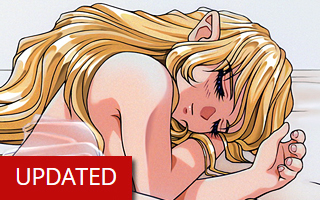
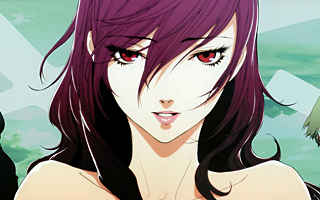
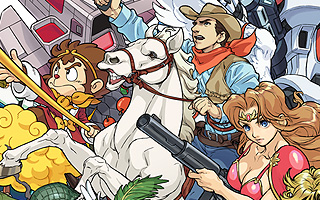
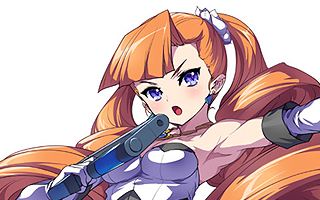
Do you agree with this list? Let us know what you think by leaving a comment below. Your opinion matters!